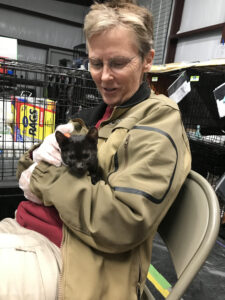Disaster Preparedness for Domestic Violence Survivors with Pets
August 14th, 2025
By Beth Gammie, Director of Field Services –
 Early this month, I presented a session for the Arizona Coalition to End Sexual and Domestic Violence (ACESDV) on how domestic violence survivors can prepare for crises like disasters and be ready to evacuate with their beloved pets.
Early this month, I presented a session for the Arizona Coalition to End Sexual and Domestic Violence (ACESDV) on how domestic violence survivors can prepare for crises like disasters and be ready to evacuate with their beloved pets.
There are four major things to consider when making your plan on how to be ready and able to evacuate with your pets:
- What kind of risks/disasters you are likely to face; and
- Where you will go;
- When should you leave; and,
- How you can leave with your pets
What are the potential risks?
For most people, the most likely disaster they will have to face is something going wrong in their home or apartment building – a fire, power going out (and therefore being unable to stay there in extreme heat or cold), or tree damage from a storm. These are “individual” or localized disasters, but people also face larger disasters affecting their whole town or community – such as wildfires, hurricanes, flash floods in a storm, lightning, and tornadoes.
Where will you go?
It’s a good idea to have a plan for a localized disaster, such as a house fire – will you stay with friends, family, a hotel, or a motel? But in the case of a disaster affecting your whole area (such as a hurricane), you will need to evacuate out of the impacted region. Consider keeping on hand information for evacuation sites further out of your local area, as well.

When should you leave?
Challenges the disaster causes regarding getting out of town may make the timing of evacuating difficult. Hurricanes, fires, and flooding often cause roads to shut down. Also, you want to make the decision to evacuate ahead of the disaster impacting the roads, so you are not out there when the hurricane or fire hits. So plan on leaving early enough, given the likely impact on your evacuation route.
How can you leave with your pets?
In order to leave your home with all your pets, you’ll need carriers to put them in, and will need to make sure all the loaded carriers will fit in your vehicle. Cats need to be put in carriers, and it’s a good idea to have them in harnesses with a leash attached, to better secure them when you open the carrier. Dogs can typically travel outside of a carrier or crate, but it is a good idea to have a wire cage for them to be secured in when you get to your evacuation site, whether it is a hotel or an emergency shelter. Of course, all pets should have collars on them with your name and phone number in case they get loose – remember that this will be a very stressful event for them, and even if they are usually well-behaved, you should take extra care in keeping them secure. And all dogs and cats should be microchipped so that in the unfortunate event that you are separated, it will be easier to reunite. Finally, make sure you bring all their medications, food bowls, and blankets/toys to give them comfort on the road.
We now know that “if it’s not safe for you, it’s not safe for your pet.” With a little bit of planning, you’ll be ready to go and take your pets with you should disaster strike.



